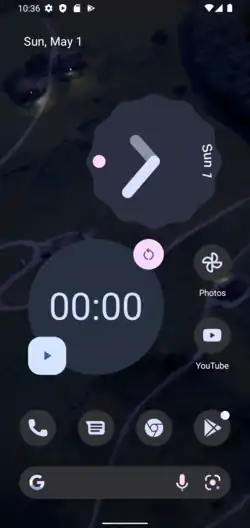Android 13
Android 13 (internally codenamed Android Tiramisu)[2][3][4] is the thirteenth and upcoming major release of the Android mobile operating system, developed by the Open Handset Alliance led by Google.
| A version of the Android operating system | |
 | |
Screenshot  | |
| Developer | |
|---|---|
| OS family | Android |
| Latest preview | Beta 1 / April 26, 2022[1] |
| Kernel type | Monolithic Kernel (Linux Kernel) |
| Preceded by | Android 12 |
| Official website | developer.android.com |
| Support status | |
| Beta 1 | |
History
Android 13 (internally codenamed Tiramisu)[5] was announced in an Android blog posted on February 10, 2022,[6] and the first Developer Preview was immediately released for the Google Pixel series (from Pixel 4 to Pixel 6, dropping support for the Pixel 3 and Pixel 3a). It was released 4 months or so after the stable version of Android 12. Developer Preview 2 followed later, releasing in March.[7] Beta 1 was released on April 26, 2022.[1] Three more beta versions are planned to be released, in May, June and July. Platform stability will be reached in June, with Beta 3. The final release of Android 13 will start in September.
Features
Privacy
Android 13 includes several new features intended to enhance user privacy, both user-facing and developer-facing.
A new media picker is added, which improves privacy by allowing users to choose which photos and videos apps have access to.[8] Most apps have not implemented this picker yet. In addition, 13 introduces a new permission, NEARBY_WIFI_DEVICES. This permission allows access to various Wi-Fi related functions, such as searching for nearby devices and networks without needing to request access to location, as the implementation was in prior Android versions.[9] Apps are now required to request permission from the user before they are able to send notifications.[10]
User Experience
Small changes to dialog windows such as the Internet toggle have been added, making them fit better with the design language. As of Developer Preview 2, the media player has been redesigned, now using the album cover as a background, and including more user controls.[11] Additionally, silent mode now disables vibration completely, including haptics.[12] The multiple users feature has been improved, with now the possibility of selecting which apps can be accessed from the guest user. App data is sandboxed between users, so no information is shared.
New Features
Support for Bluetooth LE Audio and the LC3 audio codec, which enable receiving and sharing audio between multiple bluetooth devices simultaneously, it can also improve the audio quality and battery life of the connected devices, as long as they also support it.[8][13][14][15] This version opens the support for third-party apps to use themed Material You icons.[8] Long-pressing and dragging a notification will allow the notification to open in split screen view. This feature is available on phones as well as tablets.[10]
Tweaks
Split Screen mode now persists through app changes, meaning it is possible to use other apps and the phone launcher, and split screen apps will stay paired together in the Overview menu. Animations have been improved, notably the fingerprint scanner glow on the Pixel 6 series. Overflow notifications on the lock screen also are housed in a dynamically sized pill rather than a bar, and the 2-line stacked clock is slightly smaller.[10] The app label font has been changed in the Pixel Launcher, and subtle haptics have been added throughout the user experience. The version easter egg remains the same as Android 12, but the Android version has been changed to "Tiramisu" in settings and the Quick Settings panel. As of Developer Preview 2, "Tiramisu" is replaced with "13".
Many of the changes are from Android 12L, such as the dock displayed on large screens, and other improvements for large format devices. These are mainly intended for foldables and tablets, but it can be enabled on phones too by changing the DPI settings.
References
- "The first Android 13 beta is available now". Engadget. Retrieved 26 April 2022.
- "'Panlingual' feature for per-app language settings planned for Android 13". androidpolice.com. androidpolice.com. 23 December 2021. Retrieved 25 December 2021.
- "Google may have already revealed the dessert name for Android 13 "T"". xda-developers.com. xda-developers.com. Retrieved 25 December 2021.
- "PLATFORM_VERSION_CODENAME is being updated from T to Tiramisu". android-review.googlesource.com/. android-review.googlesource.com/. Retrieved 25 December 2021.
- Porter, Jon (11 February 2022). "Yep, Android 13's dessert codename is 'Tiramisu' after all". The Verge. Retrieved 11 April 2022.
- Android Developers (February 10, 2022). "The first developer preview of Android 13".
- "Android 13 Developer Preview 2". Android Developers Blog. Retrieved 2022-03-18.
- "Features and APIs Overview | Android 13 Developer Preview". Android Developers. Retrieved 2022-02-28.
- "New runtime permission for nearby Wi-Fi devices | Android 13 Developer Preview". Android Developers. Retrieved 2022-02-28.
- Li, Abner (2022-03-17). "Here's everything new in Android 13 Developer Preview 2 [Gallery]". 9to5Google. Retrieved 2022-03-18.
- "Android 13 DP2 Brings Redesigned Media Player & Output Picker". Android Headlines. 2022-03-18. Retrieved 2022-03-18.
- "Android 13 will disable all haptics in Silent mode". xda-developers. 2022-02-11. Retrieved 2022-02-28.
- "Android 13 may finally bring full support for Bluetooth LE Audio". xda-developers. 2021-12-22. Retrieved 2022-04-22.
- "New LC3 Encoder (I5f2f7627)". AOSP Gerrit. Retrieved 2022-04-22.
- "Add new LC3 decoder (I275ea8ba)". AOSP Gerrit. Retrieved 2022-04-22.
.svg.png.webp)